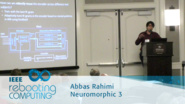8,108 resources related to
Electromyography
Top Conferences on Electromyography
2024 46th Annual International Conference of the IEEE Engineering in Medicine and Biology Society (EMBC)
2023 IEEE International Symposium on Circuits and Systems (ISCAS)
2022 IEEE Canadian Conference on Electrical and Computer Engineering (CCECE)
2022 IEEE Sensors
2022 IEEE International Symposium on Medical Measurements and Applications (MeMeA)
2022 9th IEEE RAS/EMBS International Conference for Biomedical Robotics and Biomechatronics (BioRob)
2021 18th International Conference on Electrical Engineering/Electronics, Computer, Telecommunications and Information Technology (ECTI-CON)
2021 Global Medical Engineering Physics Exchanges/ Pan American Health Care Exchanges (GMEPE/PAHCE)
ICASSP 2021 - 2021 IEEE International Conference on Acoustics, Speech and Signal Processing (ICASSP)
2021 10th International IEEE/EMBS Conference on Neural Engineering (NER)
2021 44th International Convention on Information, Communication and Electronic Technology (MIPRO)
2020 IEEE International Conference on Systems, Man, and Cybernetics (SMC)
2019 IEEE/RSJ International Conference on Intelligent Robots and Systems (IROS)
2018 IEEE Haptics Symposium (HAPTICS)
2018 IEEE Biomedical Circuits and Systems Conference (BioCAS)
2018 IEEE International Conference on Robotics and Biomimetics (ROBIO)
2018 IEEE 14th International Colloquium on Signal Processing & Its Applications (CSPA)
2018 9th Cairo International Biomedical Engineering Conference (CIBEC)
2017 14th International Multi-Conference on Systems, Signals & Devices (SSD)
2017 21st National Biomedical Engineering Meeting (BIYOMUT)
2016 Sixth International Conference on Instrumentation & Measurement, Computer, Communication and Control (IMCCC)
2015 9th ICME International Conference on Complex Medical Engineering (CME)
2015 8th International Congress on Image and Signal Processing (CISP)
2015 8th International Conference on Biomedical Engineering and Informatics (BMEI)
2014 ISSNIP Biosignals and Biorobotics Conference: Biosignals and Robotics for Better and Safer Living (BRC)
2013 International Conference on Communications, Circuits and Systems (ICCCAS)
2013 6th International Conference on Intelligent Networks and Intelligent Systems (ICINIS)
2012 IEEE Electronics, Robotics and Automotive Mechanics Conference (CERMA)
2012 Third Asian Himalayas International Conference on Internet (AH-ICI)
2012 IEEE/ASME 8th International Conference on Mechatronic and Embedded Systems and Applications (MESA)
2011 International Conference on Control, Automation and Systems Engineering (CASE)
2010 International Conference on Future Information Technology and Management Engineering (FITME)
2010 Third International Symposium on Intelligent Information Technology and Security Informatics (IITSI)
2010 International Symposium on Computer, Communication, Control and Automation (3CA)
2009 International Conference on Biomedical and Pharmaceutical Engineering (ICBPE)
2009 International Conference for Technical Postgraduates (TECHPOS)
2009 IEEE Toronto International Conference - Science and Technology for Humanity (TIC-STH 2009)
2009 IEEE International Symposium on Computational Intelligence in Robotics and Automation - (CIRA 2009)
2005 1st International Conference on Neural Interface and Control (CNIC)
More links
Top Videos on Electromyography


Xplore Articles related to Electromyography
Periodicals related to Electromyography
Pattern Analysis and Machine Intelligence, IEEE Transactions on
More links